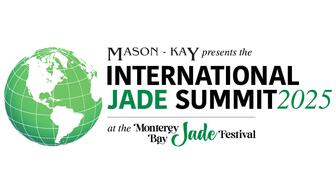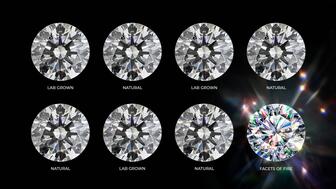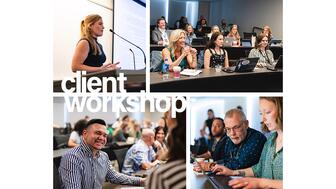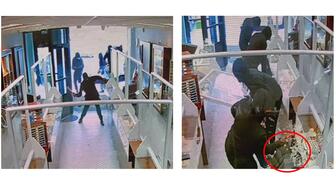A pink topaz Belle Époque pendant-brooch and a Victorian Egyptian Revival choker were also highlights at a recent Anderson & Garland sale.
Squirrel Spotting: 5 Reasons I Hate Memo
Fresh off another trade show, Peter Smith shares his thoughts on the widely used, and much debated, practice.

I have long detested memo but have never been exactly sure why. I mean, I don’t just dislike the concept of memo, I even despise the word itself. It is, I confess, a personal idiosyncrasy that’s certainly based more on emotions than anything cognitive.
Nonetheless, the feeling persists and it tends to come to the fore at and post tradeshows. Understandable, I suppose, given the prevalence of memo requests that seem to serve as an all-too- familiar soundtrack at the shows.
I have found myself thinking more and more about the “memo concept” in recent weeks and months.
I’m grateful that I’ve personally never worked for any companies where memo was a significant part of the business model and so I have very little exposure to the worst of it. That said, here are a few of my thoughts on why I don’t like it.
Memo Is Not a Strategic Initiative
I struggle to understand how getting “free” products ever makes sense as a meaningful business model.
For instance, if a retailer articulates his or her product strategy, with the attendant curated stories and brands, is it likely that a select number of vendors will give you their very best products on memo to support that? Assuming not, how could getting second-rate memo products that don’t align with your strategy be good for your business?
Supply and Demand Don’t Align
The very concept of memo seems to be the result of a failed strategy on the vendors’ parts. It suggests that supply far exceeds demand and, if that scenario is true, why is there not more demand for that product? What does it say about the product’s value proposition or, more aptly, its lack of value? Does it become more relevant filling out a jeweler’s case or, as I heard from one retailer recently, sitting in a safe?
There ought to be fundamental questions asked about the product development process of those companies, and the quality and/or viability of their products that are, at best, being flung at the nearest wall in the hopes of finding traction. Memo as a Hail Mary, you might say.
More is Not Better
A not-too-often-discussed side effect of memo is that it very often contributes to one of the biggest challenges in retail (all retail, not just jewelry) today, and that is the preponderance of “stuff” in the stores and showcases.
I have written
Be Like Tiffany
Connected to the overcrowding, of course, is the retail aesthetic. No showcase was ever better for having too much product.
In a series of “Future of Retail” talks that I gave around the country in the fall, I shared SKU counts for stores as diverse as Apple, Michael Kors, Coach and Tiffany & Co., and I then compared them to the SKU counts of four independent jewelry retailers.
If the latter were boats, they would have sunk, so overloaded were they with inventory. The former group—amongst the top retailers in terms of per-square-foot of sales in the country—understand that their business model is not well-served by overloading with products.
What Do I Want My Salespeople to Focus On?
Why do I want my salespeople to spend their time on memo? Wouldn’t I rather have them selling my asset products? Or are you the retailer without an aged product problem?
It is possible, I suppose, that you might be savvy enough to merchandise your memo in such a way that your salespeople can skillfully navigate asset and memo, and use the latter to fill in only where there are obvious gaps. You might, but I doubt it. Contributing to the aging of your asset inventory by selling memo goods and, potentially, paying more for them might not be the wisest course of action.
Then again, I don’t know. I might be all wrong about this memo thing.
As Kevin Dutton wrote in his book Split-Second Persuasion: The Ancient Art and New Science of Changing Minds: “When the chips are down and the going gets tough, the brain, it would seem, spends much of its time cowering behind the heart.”
It works for me.
Peter Smith is president of Vibhor, a public speaker and author of “Sell Something” and “Hiring Squirrels.” He spent 30 years building sales teams in retail and wholesale and he can be contacted at dublinsmith@yahoo.com, peter@vibhorgems.com, or on LinkedIn, Facebook or Twitter.
The Latest

The event, which will co-locate with the Monterey Bay Jade Festival, will bring education sessions focused on jade to the United States.

The charm is a celebration of springtime as April showers bring May flowers with the piece’s cluster of diamond raindrops.

Bench jewelers spend years honing their skills, Jewelers of America’s Certification validates their talents.

The National Retail Federation expects retail sales growth to return to pre-pandemic levels as consumers continue to face inflation.


The 4-carat, old mine brilliant-cut diamond engagement ring was co-designed by Willis and New York City-based brand Karina Noel.

Rio Tinto unearthed the diamond at its Diavik mine in Canada’s Northwest Territories.

Natural diamonds mean more than lab-grown, but when every cut is ideal, they all look the same. Customers want more—Facets of Fire delivers.

The multisensory experience, open April 8-13, will feature the brand’s silver creations among dream-like scenes of natural landscapes.

The virtual event will take place April 7 at 3 p.m.

The pieces in “Animali Tarallo” portray animals from stingrays to elephants through portraits and interpretations of their patterns.

Parent company Saks Global said the iconic location will be open through the holiday season as it decides what to do with the space.

Ronald Winston, son of Harry Winston, donated the diamonds to the Smithsonian National Museum of Natural History in Washington, D.C.

The educational event will take place in Charlotte, North Carolina, this May.

The layoffs come amid the TV shopping channel’s efforts to restructure and focus on live shopping through social media.

The debut event will take place in Miami’s Coconut Grove neighborhood this fall.

The roundtable will take place May 17 ahead of the trade show’s welcome dinner.

The “Peanuts x Monica Rich Kosann” collection features the comic strip’s classic vocabulary across 10 bracelet designs.

Three industry experts dive into the complexities of the material often marketed as an “ethical” alternative for metal in jewelry.

Diamonds are not only one of the most prominent gemstones, but the birthstone for those born in April.

The Utah-based company known for making wedding bands has acquired Doubloon Golf.

The longtime luxury executive led one of LVMH’s watch brands, TAG Heuer, for 12 years before taking over Bulgari in 2013.

Authorities said the robbers fled with jewelry and 70 Rolex watches, later taking pictures of themselves posing with big stacks of cash.

Lotus Gemology founder Richard W. Hughes has translated Heinrich Fischer’s 1880 book “Nephrit und Jadeit” from its original German.

The ring's design features contrasting lines influenced by work from architecture-inspired photographer Nikola Olic.

The Conference Board’s index fell as consumers continued to worry about the impact of tariffs, the labor market, and the price of eggs.

However, two medieval jewels surpassed estimates at Noonans Mayfair’s recent jewelry auction in London.




























